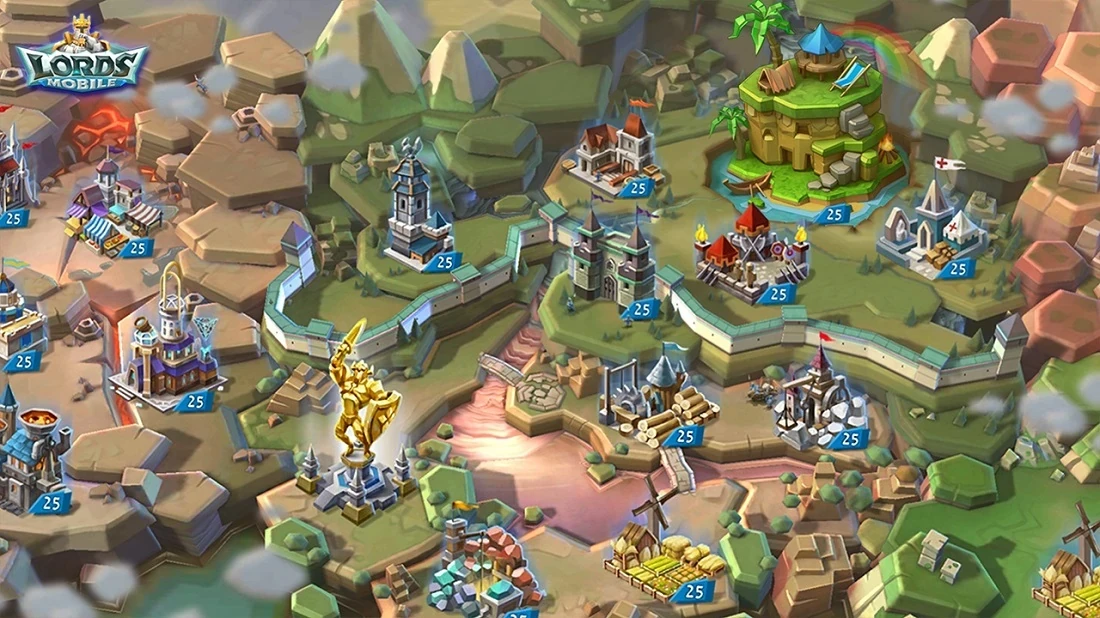Would your 50-year old neighbor understand your mobile game tutorial? How about that 15-year old walking down the street?
Today, mobile gamers are a more diverse group than ever before. For this reason, your mobile game tutorial needs to be universally understandable.
How can you achieve that?
Well, you can start by reading this article. You will learn about different types of tutorials, as well as the best practices for building them. Plus, I’ll analyze a couple of examples from popular games.
Mobile Game Tutorial: A Huge Part of Your Game
When players launch your game, you need to get them started. Among other things, you need to teach them how to play your game.
The first-time user experience (FTUE) is something that can make or break a game.
The mobile game tutorial is the most significant part of this experience. It helps to onboard users, shows them your game’s value, and impacts early retention.
For all of these reasons, it’s crucial to do it right.
A good mobile game tutorial explains the basics of the game and prepares players for playing solo. Also, it should be an enjoyable and straightforward (as it gets) experience for the players.
Challenges of Building a Mobile Game Tutorial
Some games out there don’t even have a tutorial. On the other hand, a lot of them have bad tutorials.
There are different reasons why this happens.
One of them is building the tutorial last.
Many developers first work on the gameplay. After that, they focus on different features, bugs, etc. All of this drains their tutorial budgets. For this reason, many of them decide on the cheapest instead of the best options for the tutorials.
When building a tutorial, developers face another big challenge – getting into the players’ heads.
The thing is, they’ve played their games hundreds of times. For this reason, it’s hard for them to spot the game’s flaws. They have an especially tough time figuring out where the players might get stuck.
Types of Mobile Game Tutorial
There are different types of mobile game tutorials. Some of them are considered to be better than others. On the other hand, others fit certain genres best.
Let’s take a look at the three basic types of mobile game tutorials.

Tutorial by Exposition
This old-school tutorial educates players on how something is done outside of gameplay.
For example, textual explanations or the “controls screen” before starting the gameplay.
This type of tutorial is easy to implement. However, this is practically the only good thing about it.
The biggest problem? It’s not memorable enough.
It’s like when you get instructions to put together a piece of furniture. Imagine you can only read the instructions once, and then you’re left on your own.
When players get such instructions and get thrown into gameplay, they frequently end up confused.
Therefore, no matter how simple your game is, we don’t recommend this type of tutorial.

Tutorial Room
This is a special gameplay section where players are taught how to play the game. This section is made just for teaching purposes and doesn’t exist anywhere in the game.
This type of tutorial also takes place before actual gameplay. Yet, it’s much more memorable than the previous type.
The reason? This type of tutorial is interactive.
Here, players get a good understanding of how the game works. Besides just telling players what to do, they need to interact and act on the instructions.
However, the tutorial room is not suitable for all types of games. For example, it’s hardly a good idea to include a tutorial room in a game from the casual genre. On the other hand, it has proven to be particularly effective in strategy games.
In many games, players get the option to skip this type of tutorial.
Since they usually last a while, and some players already know how to play, it’s a good call to make this type of tutorial optional.

Contextual Lesson
Just like its name suggests, the contextual lesson is all about context.
In this type of tutorial, the game teaches players how to play throughout gameplay. It appears in particular gameplay moments.
This way, players learn how to react in different situations. After all, the easiest way to learn something is by looking and engaging with it.
You can think of it as a tutorial room but chopped into smaller pieces.
The contextual lesson tutorial is suitable for all sorts of games. We can find examples of it everywhere, from hyper-casual titles to mid and hard-core games.
The difference?
Games with simpler mechanics will teach players all they need to know in the first couple of minutes.
In more complex games, the contextual lesson will appear at the beginning but also later in the game. For example, when players unlock new and unfamiliar features.
Best Practices for Building a Mobile Game Tutorial
You’re here for the tips?
You’re in luck, because I’m bringing you quite a lot of them. Here are 12 tips that will help you build better tutorials.
1. Make It Feel like a Natural Part of the Game
A lot of your players have experienced bad tutorials in the past. For this reason, they frequently think of them as a waste of time before they get to the good part – actually playing the game.
You can prove them wrong.
Don’t think about the tutorial as an isolated part of the user experience. Instead, ask yourself – How can I make the learning part feel like a seamless part of the gameplay experience?
If you do this right, your players should not be able to tell where the tutorial began and where it ended.

2. Spread It Out
When players start playing your game, you don’t have a lot of time until they lose interest in it. And you most definitely don’t want that to happen during the tutorial phase.
For this reason, you should start with the bare minimum. In the tutorial, give players only the basic instructions on how to play your game.
You may be thinking – My game has impressive depth, and I want to show it off to players right away.
Don’t.
Think about this.
When players finish the onboarding phase, they become increasingly invested in the game. The more invested they are, the more receptive to learning new things they become.
As the players progress through the game, you gradually introduce new knowledge. To do this, you need to break the tutorial into smaller pieces.
Every time players discover new areas of the game, give them crumbs of knowledge (e.g.,, when you introduce a new meta layer, mechanic, or feature.
With this approach, you’re preventing information overload. Hence, it should be easier for players to memorize everything they’ve learned.
3. Make Players Act, Not Read
Our whole lives, we people learn things in different textual forms. Ugh, textbooks.
Text is packed with information but also quick and easy to create. For this reason, a lot of game developers include chunks of text into their games.
The problem?
Reading text lines can get boring and it can take a while, especially in something as interactive and visual-based as a mobile game.
In fact, 80% to 90% of players don’t read tutorial text (Mobilefreetoplay).
For this reason, you should focus on teaching players by doing, not reading. This turns the learning experience into something memorable and entertaining. For this reason, you should make your mobile game tutorial as interactive as possible.
Naturally, the simpler the game’s mechanics is, the easier it is to do this.
However, some games have complex mechanics that are difficult to explain without text instructions. For example, strategy games. If your game falls into this category, you don’t have to lose all the text.
Instead, try to keep the text to a minimum. This brings me to my next point.

4. Don’t Use Too Many Words
You may be wondering – how much text is too much text?
According to George Fan, the creator of Plants vs. Zombies, there should never be more than eight words on the players’ screens.
This is not a strict rule, but it’s definitely a useful guideline. Either way, when it comes to mobile game tutorials, shorter is almost always better.
Why?
Well, the simpler the rule, the more likely the players will read and memorize it. Plus, if players can read the text at a glance, it doesn’t slow down gameplay.
Psychology also plays a role here.
The thing is when players get breadcrumbs of text, and they figure it out quickly, it makes them feel smart.
However, if you’re delivering a lot of text to players at once, they can perceive it as condescending. For this reason, avoid long chunks of text to make your players feel better about themselves.
5. Don’t Think of Your Players as Fools
Even though new players don’t know how to play your game, they aren’t entirely ignorant. The thing is, the players bring their previous life experiences into the game space.
For instance, they know that steering wheels control the car, that turtles move slower than humans, that it snows during winter, etc.
All of these things are common knowledge, and the average player is aware of them. Hence, you don’t need to teach players such things.
On the contrary, gameplay features should be adequately explained.
Sometimes, you will notice that your players repeatedly make the same mistakes. This may happen because they haven’t noticed some of the rules. Therefore, you can give them some extra instructions.
However, if players keep playing the same way, don’t beat them over the head with this. In other words, don’t assume the players don’t know how to do it correctly; they probably just don’t want to.

6. Leverage the “How”, but Also the “Why”
A lot of mobile game tutorials focus on teaching players how to do something. For example, drag an object to move it, double-tap to jump, etc.
This frequently leaves players wondering – Why should I do this?
If you teach players how to jump, you should also make it clear why they need to jump. For example, to avoid obstacles or to reach some kind of reward.
By doing this, you’re creating an intuitive environment for the players. If they know why they need to do something, they might go ahead and explore things on their own.
This should make them feel empowered, self-led, and smarter.
7. Keep It Fun
While trying to balance all of the elements a good mobile game tutorial should have, it’s easy to forget one of the most important things – it should be fun for players.
The goal here is to come up with a tutorial that’s educational, simple, and engaging all at the same time. People tend to learn better while they’re having fun.
To accomplish this, identify game elements that are important for players to learn as well as those that are the most fun and include them in the tutorial.
But ultimately, even if your game tutorial is not perfect but players find your game endlessly fun because of it, that’s a win.
8. Don’t Pollute the Tutorial
When players first launch your game, you want to show them so many things.
For example, the game’s narrative, the character introductions, your sense of humor…
All of these things can be a part of the players’ first-time-user experience. For example, the narrative can begin before the tutorial.
However, when it comes to the tutorial itself, it needs to be relevant and to the point.
Everything that goes beyond the basic instructions within the tutorial creates noise.
For example, if you’re teaching players how to do something, don’t just randomly introduce a character. This can be confusing for players.

9. Introduce Players to Your In-Game Economy
Does your game economy include hard or premium currency?
If yes, the tutorial is a great place to show players how to use it.
Basically, you want to use the tutorial to show players the value of the currency. To achieve this, show them how they can earn it and spend it.
You can also take this a step further – teach players how to buy currency.
Of course, in the tutorial, you shouldn’t ask players to spend any money. Instead, communicate something like, “Here’s our little treat to get you started.”
Doing something like this makes you look generous in the players’ eyes. Therefore, it creates a positive connection between you and the players.
Moreover, this allows you to display the IAP screen. Your ultimate goal is to make players make purchases. Showing them how they can do this early can be beneficial later in the game.
10. Adapt and React
When you’re teaching players the basics, it’s okay to give them explicit instructions.
However, if your tutorial is spread throughout the game, adapt your messaging.
Later in the game, the instructions shouldn’t be too bossy. These players already know how to play. For this reason, the instructions should come as hints and suggestions.
Also, they should be in line with the players’ progress and current needs.
When experienced players get pushy instructions on something they know, this can make them mad. In such a situation, they feel smarter than the tutorial.

11. Make Sure Your Messaging is Unobtrusive
Should your instructions take over the players’ screens? Or should you go with a small hint banner?
Go with the banner.
The difference between the two is quite apparent. The pop-up interrupts the game and demands the players’ attention.
On the other hand, the banner is considered a passive form of communication. It does not interrupt the player’s activity at the given moment. Plus, it can stay on the players’ screens until they take the proper action.

12. Use Visuals Effectively
Visuals are a powerful teaching tool.
The clearer the visuals are, the easier it should be to teach players to do something.
For example, everyone knows the meaning behind a pointing hand or an arrow. For this reason, a lot of games use these elements in their tutorials.
It’s also helpful if the in-game objects have a clear purpose. For example, a box probably means there are things inside it, food is probably to be eaten, etc.
On the other hand, when the in-game objects are abstract, they require additional explanation.
13. Measure, Track and Optimize
You may believe that you’ve created an excellent great mobile game tutorial.
However, you can’t rely on your intuition here.
Instead, you need to know how your players act during the tutorial. Only if you know this will you be able to figure out how they feel about it. For this reason, you need to measure and track each stage of the tutorial.
To do this, you need to create events for every step in the tutorial. The events then send the information to the game analytics tool you’re using. These events form a tutorial funnel.
By observing the funnel, you will be able to find flaws in your tutorial. For example, you may find out that there is a problem with the information you’re presenting to players. Or that the action you ask players to do in the tutorial is too complicated.
Wherever you notice a drop-off, there is a pain point for players.
For example, if you notice players churn at the beginning of the tutorial, it’s possible they don’t know how to proceed with it. Or they simply don’t like how your game looks and feels.
If you notice a drop-off at the end of the tutorial, the issues are different from those at the start. For example, perhaps the players are confused by all the information or the game’s user interface.
Whatever issue you detect, you need to optimize it.
First, determine the possible problem. Next, apply one change at a time. If the issue is fixed, you did the right thing. If not, try changing something else.
Examples of Mobile Game Tutorials in Popular Games
Let’s go over two mobile game tutorial examples from two popular games.
One of these games is a relatively simple puzzle game. The other is a more complex strategy game.

Merge Mansion
Before the tutorial, Merge Mansion introduces players to its narrative and the game’s protagonist.
Soon after, the players are thrown to the game’s merge board. This is where the tutorial begins.
The main thing the game tutorial has to teach players in this game is how to merge.
Sure, some players have previously played other merge games, so they may already know how to do that. However, the basic assumption is that this is their first time playing.
This shouldn’t upset experienced players. The thing is, the basic instructions don’t last too long.
On the merge board, players get short written instructions and pointers. Both of these show them what to do in certain situations. All of this happens throughout gameplay, so this tutorial is considered a contextual lesson.
This tutorial is very well done.
Here’s why.
First, the text instructions appear as small banners. As such, they don’t interfere with the user experience.
Second, the game uses the protagonist as the tutorial character. This is a positive practice because it can create a connection between the players and the character.
Third, the tutorial is spread throughout gameplay. Whenever the game adds a new feature, it teaches the players about it.

League of Legends: Wild Rift
Lol: Wild Rift is a very complex game. For this reason, it needs to deliver a LOT of information in the players’ first sessions.
This is quite a challenge for the developers.
In this game, the developers have decided on a forced tutorial. All players need to pass it before they start playing.
This is a good call. Newcomers definitely can’t afford to skip the tutorial. On the other hand, players who’ve played the PC version need to adapt to the mobile version of the game.
The tutorial room is where players can interact with “fake gameplay”. It happens on the same map where the actual gameplay takes place. However, instead of real players, here they fight AI creatures.
In the tutorial, players get short written instructions, and they learn how to move, activate powers, etc.

Besides these instructions, they can also interact with additional textual instructions. This is the type of game where it’s difficult to minimize the amount of text on the screen. Considering this fact, the developers did a solid job.
After exiting the tutorial room, players should be able to pick up the ropes of the game. However, some new players may still feel overwhelmed.
This is not because the tutorial is bad.
The game is simply that complicated.
Luckily, the developers are aware of this issue. For this reason, players can revisit the tutorial room whenever they want.
On the other hand, some players will figure out the basics but crave additional knowledge. For these players, the game offers extra, optional tutorials.
Over to You
That’s it! That is everything you need to know about building a great mobile game tutorial.
If you want to see some more examples, check out some of our mobile game dissections. In these articles, you will find detailed analyses of top mobile games – tutorials included!







Comments